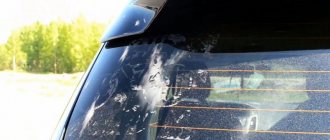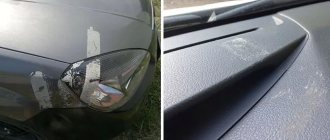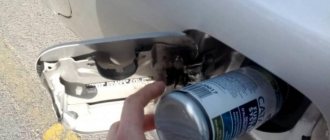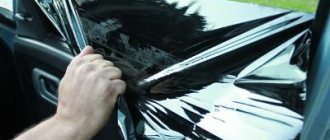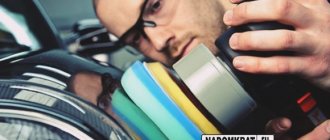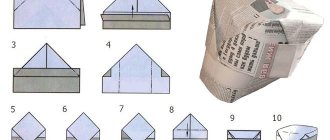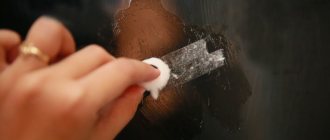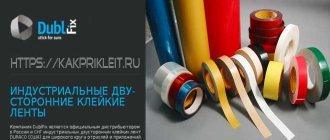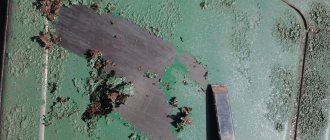Many car owners use tuning for their car as a method of improving its appearance. Some use expensive body kits and unusual decorative elements for this, and some improve the type of transport by gluing various images on them. Often, stickers on a car can arise as a result of the car owner’s desire to make money by sticking advertisements.
Regardless of how the sticker appears on your car, sooner or later there comes a time when it needs to be removed. It turns out that removing a boring pattern from the body or glass of a car is much more difficult than gluing it. In this article, we will look at how to remove the sticker and residual fragments of the adhesive base from the surface of the vehicle, without causing damage to the paintwork and glass surfaces during the process.
Materials required for work
Most modern car stickers, presented in a decent assortment on the market, are made on the basis of high-strength, reliable, moisture-resistant, temperature-resistant vinyl. Emblems and images are primarily intended for one-time use, have an adhesive surface, and have a decent service life, sometimes more than three years. Such super-positive quality characteristics position car stickers from the best side, which, from a different position, causes difficulties when they need to be removed.
Before starting to remove the sticker, the car owner should prepare accordingly: purchase the necessary materials and tools for the work, prepare himself mentally for a responsible, jewelry-making process that requires scrupulousness and diligence. Materials may vary depending on the method of carrying out the procedure, however, there is a clear minimum, which looks like this:
- Warm water and several small clean rags to pre-clean the surface from dirt accumulations and treat the surface under the sticker after its removal. Car shampoo or any other non-aggressive detergent may also come in handy.
- A professional or powerful household hair dryer for heating the adhesive base in order to soften it before removing the picture.
- To directly undermine the edge of the emblem and remove it, you will need a plastic spatula; as an alternative, an old plastic card or other durable, non-metallic, flat object may be useful.
- As a liquid for eliminating residual components of the adhesive base, you can use either special solutions, having previously purchased them at a car store, or gasoline and kerosene available to each car owner. You should be very careful when choosing a liquid so that it is not aggressive to the components of the paintwork.
- If you intend to remove an adhesive object from the body, polishing paste will be needed to smooth out the discrepancy in the color of the body with the area that was under the sticker.
In addition to preparing the materials necessary for direct work, it is important for the performer to focus on his safety. When working with aggressive components, it is important to take precautions, wear thick work clothes, gloves and safety glasses.
Method number 3: household chemicals
In order to remove the old sticker, special means are used - liquids, solutions, aerosols. They are sold under the following trade names:
- "sticker remover";
In order to clean your car glass, choose not the usual window cleaner from the household chemical store, but a special one. Buy specific products made for cars. Its instructions must indicate its automotive purpose. Such products are sold exclusively in auto chemical departments. Their marking “for cars” guarantees the safety of the glass of your vehicle.
Another useful gadget for the driver is a car window defogger. Read about the features of its choice in the article by our specialist.
Additionally, we recommend reading a very detailed and interesting material on the purchase and use of anti-rain for car glass.
Chemical decal removers can be liquids or aerosols.
In order to remove the sticker, you must follow the instructions included with the drug. It is usually recommended to apply the product to the surface of the sticker, hold it for a while and then remove the peeling paper and glue with a cloth. What problems may arise during the removal process with a chemical agent?
The adhesive base under the paper or coating may undergo changes under the influence of the sun and temperature on the windshield. It can turn from a soft glue into a hard substance resembling plastic. A chemical reagent applied to its surface can only remove part of the old glue, its top layer. What to do in this case? It is necessary to apply the adhesive remover again to remove all of its residue. So, in several passes, you can remove a sticker that has been hanging on the rear or windshield for several years.
Note: Since household chemicals can be aggressive, you may need latex gloves to protect your hands. The need to work with gloves is also written in the instructions for the product.
Effective ways to remove stickers
When asked how to remove stickers from a car, there are no clear instructions: the outcome of the process depends on many factors, in particular, the period it was on the car, the quality of the emblem itself and its adhesive, and location.
First, let's look at the options for removing a sticker from a car body. Professionals call the method of heat treatment of the surface as the most effective option for removing patterns from vehicle body parts, which will help soften the adhesive base, with the subsequent possibility of eliminating the sticker.
How to remove a spike sticker from a car?
The easiest way to remove a pasted pattern is to soak its adhesive layer. If the sticker was attached relatively recently, the bottom layer of glue can be softened and washed off with hot water. To do this, take hot (60 - 70 °C) water, moisten a cloth with it and cover the sticker on the glass with the cloth.
Interesting materials:
How to remove bitterness from salty Volnushki? How to remove bitterness from dried mushrooms? How to remove iodine from a mattress? How to remove iodine from the neck? How to remove excess silicone sealant? How to remove office glue? How to remove PVA glue from a jacket? How to remove barb from a sweater? How to remove headers and footers in Word 2003 on one page? How to remove lumps of padding polyester in a down jacket?
How to eliminate traces or fragments of glue from the body and glass elements of a car
The methodology for removing stickers, if they remain on the car for a long time, even with careful implementation of the process, can result in an unpleasant precedent, in the form of glue residues on the surface that cannot be eliminated. The question of how to remove glue from a sticker from a car is relevant among car owners, since the use of an unsuitable liquid can result in damage to the paintwork, with the need for a complete repainting of the car, or in a chemical effect on the glass, with its subsequent clouding and the need for replacement. None of the options is acceptable for car owners, as it involves significant financial costs.
Which product is the worst for removing stickers from car windows?
During testing, Würth Industry Clean showed unsatisfactory results on some (certain) types of labels. Even after sufficient treatment of the sticker surface itself, a large amount of glue residue remains on the glass.
Common mistakes made by car enthusiasts
An incorrect approach to removing stickers from the body or glass of a car can not only fail to produce results, but also result in serious problems. The most common mistakes when performing work on removing car stickers are the following mistakes with an unfavorable outcome:
- Heating the surface at high power with a hair dryer.
- Using metal-based tools to clean the surface.
- The use of mixtures that react aggressively with paintwork.
- Simultaneous use of chemical treatment methods on the sticker with heat treatment.
Such errors entail permanent damage to the paintwork, which results in the need for repainting or fragmentary painting of the vehicle.
Ignoring safety precautions when working with active chemicals poses a significant danger to the health of the performer. Working without protective equipment can lead to problems with the respiratory organs if special masks are not used, and contact of the performer with aggressive chemicals can cause burns.
Method No. 2: warming up or temperature action
This method can be used for “aged” stickers. Their adhesive layer is partially changed. Short-term heating of the glass surface leads to the softening of the old glue, which makes it possible to remove the sticker without leaving any traces.
We also recommend reading our author’s very useful and interesting article on how to remove tinting.
In order to pry off the pasted sticker, you can use a plastic card. It does not have sharp corners that could scratch the surface of the car glass.
If the glue is very old, then it will not be possible to remove the sticker without a trace immediately and quickly. You will have to work hard and spend time. What should you consider? Some glasses change color (slightly or strongly) due to severe overheating.
The sticker on the rear window requires the most careful removal if it is glued to the back side.
Very old glue cannot be heated even with a hair dryer. We will have to turn to the achievements of chemistry. The auto chemicals department will tell you how to remove a sticker from a car glass using modern methods.
Let's sum it up
Stickers and film vinyl coating on cars are actively used by car owners as an improvement in the appearance of the vehicle. The process of pasting, especially small-sized stickers, is one of the most affordable tuning options, which explains the popularity of this method of improving the design of a car.
Problems arise at the stage when the pasted pattern you like becomes boring or other reasons arise that imply the need to remove the emblem. Coping with this task is not always easy, since modern-made car stickers are distinguished by decent strength and durability. This article presents effective methods for dealing with stickers and glue fragments that remain when they are removed, using which any car owner can solve the problem at home.
Removing film from a car: professionally and economically
Advertising materials, vinyl films and decorative elements covering the outside of the car are impressive and stylish. But such a thin and fragile synthetic material is very short-lived, especially in the conditions of Russian roads.
So motorists have to look for someone who can remove the film from the car without damaging the car.
The MarkuS-Mr.Sar company provides this service promptly, accurately and professionally.
The car owner may need this procedure, even if the film on his car is still quite attractive, for example:
- a car with “decoration” is purchased from another owner;
- difficulties arose with selling the car due to the irrelevance of the film on its surface;
- “camouflage” got boring;
- Periodically there are problems with the traffic police and so on.
A range of film removal services
A car enthusiast, applying for a professional service for removing film from a vehicle, can order:
- just competently and carefully remove the annoying film;
- remove the old coating while applying a new one.
In both cases, the professional will use specific technologies, selected individually, based on the specific situation:
- exposure of the adhesive base of the film to chemical reagents (used for limited types of films!), non-toxic to health and neutral to the paint layer;
- I influence the film with high temperature by directing a heated air flow with a heat gun.
It is not difficult to notice that both methods require a purely professional approach, and even if the technology is followed, in the hands of an amateur it can easily turn into a source of damage to the machine.
All stickers on the car leave traces of glue
The chemicals used actually help remove stickers and that's a fact. But, there is one small “but”. All these means do not help to completely peel off all the layers on the sticker from the car. For example, during testing, after removing stickers from the car body, large traces of glue and partial sticker residues remained on it. The result is the following: in order to completely remove the sticker from the car, it was necessary, after the first stage of removal and after the surface had completely dried, to start all over again, applying the chemical agent to the surface of the car again.
Liquid "UHU" for removing labels and traces of tape
Average price in Russia: 350 rubles .
Number of points as a result of the test: 306.
Sticker remover "Wepos Aufkleber-Entferner"
Average price in Russia: 600 rubles .
Number of points as a result of the test: 311.
Sticker remover "Würth Industry Clean"
Average price in Russia: 480 rubles .
Number of points as a result of the test: 327.
Sticker remover "NIGRIN"
Average price in Russia: 790 rubles .
Number of points as a result of the test: 334.
Mellerud adhesive remover
Average price in Russia: 830 rubles .
Number of points as a result of the test: 336.
Sticker remover "Cleanextreme Aufkleber" / "Klebstoff-Entferner"
Average price in Russia: 1000 rubles .
Number of points as a result of the test: 342.
Cleaner for removing glue "TESA"
Average price in Russia: 390 rubles .
Number of points as a result of the test: 349.
Pesto glue remover
Average price in Russia: 580 rubles .
Number of points as a result of the test: 349.
Solvent for removing stickers “Solvent 50 Kontakt chemie”
Average price in Russia: 960 rubles .
Number of points as a result of the test: 351.
Sticker remover (anti-adhesive tape) “Caramba”
Average price in Russia: 850 rubles .
Number of points as a result of the test: 352.
Meyer Chemie Sticker Remover
Average price in Russia: 680 rubles .
Number of points as a result of the test: 360.
HG Sticker Remover
Average price in Russia: 350 rubles .
Number of points as a result of the test: 368.
What is included in the price of the service
In the salon, to remove the film from the car either completely, by ordering the so-called full sticking, or partially.
For example, a car owner, at his choice, can order the film to be removed from:
- hood;
- rear bumper;
- doors;
- front and/or rear wing, etc.
The pricing policy, with reasonable prices, is based on an individual approach.
The reason is the different condition of the film, its type (polyurethane, vinyl, regular polymer), the material of the car under the coating being removed (paint, glass, plastic), as well as its relief (straight and textured).
